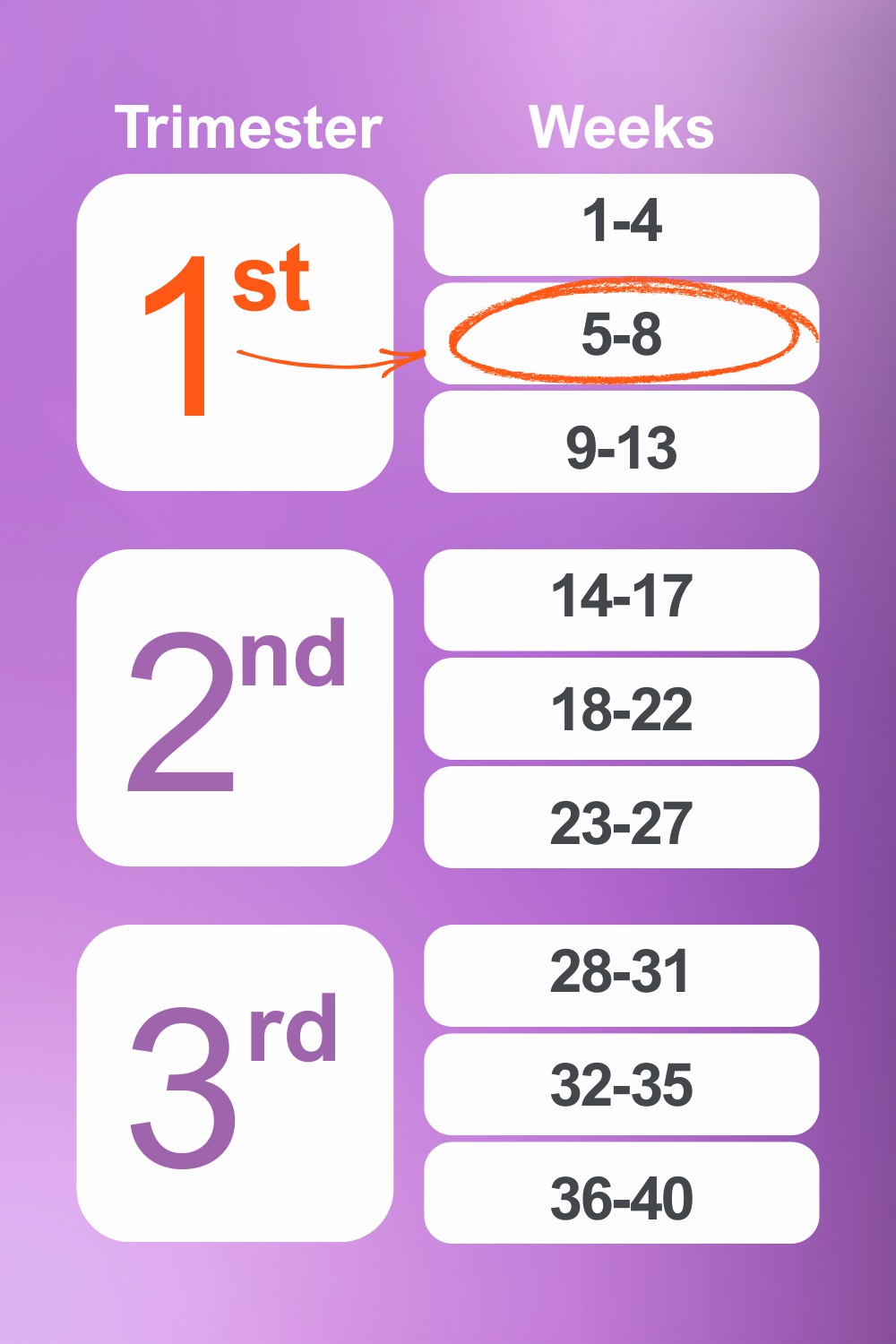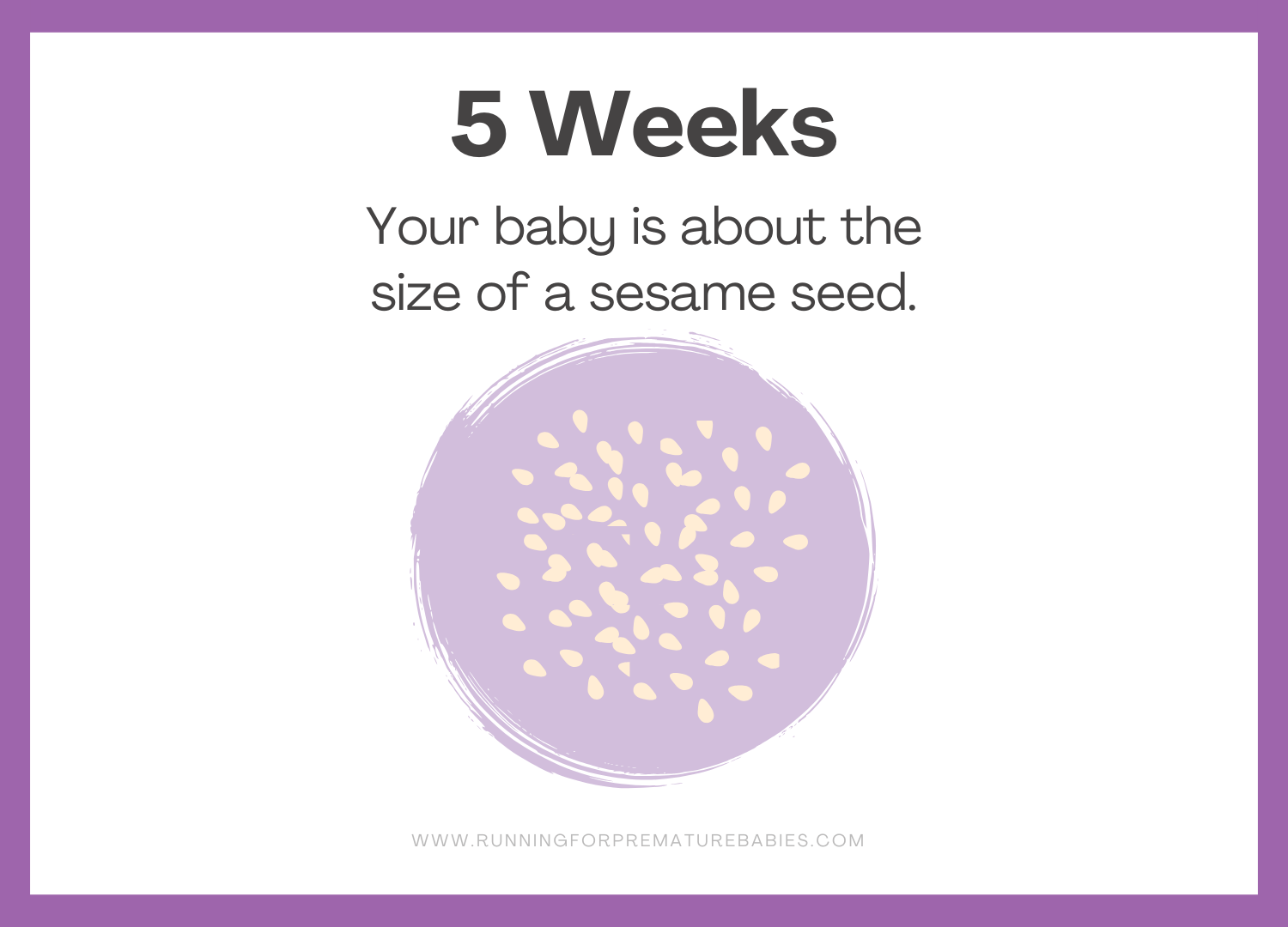Key Milestone Weeks in Pregnancy
First Trimester

Summary:

See FAQs Below
Get Involved
Run with us
Donate
Join the Premmie Marathon Challenge
FAQs
Can I get an ultrasound at 5 weeks?
You can have an ultrasound at 5 weeks pregnant, typically referred to as an early dating scan. Your doctor may suggest it to confirm the pregnancy, check the location of the embryo (to rule out ectopic pregnancy), and estimate your due date. However, at this early stage, the ultrasound might only show a gestational sac and a yolk sac. It is often too soon to see the embryo or detect a heartbeat, which is why many providers recommend waiting until around 7–8 weeks unless there is a medical reason to scan earlier. If you are considering it, it is a good idea to chat with your GP or midwife, they can help you decide if an early scan is right for you.
Can I hear the heartbeat at 5 weeks pregnant?
At 5 weeks pregnant, the embryo is still very small, and while the heart may have just started beating, it is usually too early to detect it on a standard ultrasound.
What are the chances of miscarriage at 5 weeks pregnant?
Miscarriage is relatively common in early pregnancy, with up to 1 in 4 pregnancies ending in pregnancy loss before 10 weeks. That means at 5 weeks, the risk is still present and not unusual. Vaginal bleeding or spotting in the first trimester happens in about 1 in 4 people, but it does not always mean a miscarriage will occur. Most miscarriages in early pregnancy are due to chromosomal abnormalities that happen by chance, not because of anything you did or did not do. Not all bleeding or cramps means miscarriage, but if you notice any signs, such as vaginal spotting, back pain, and loss of pregnancy symptoms, contact your healthcare provider as soon as possible.
What prenatal supplements should I be taking?
Folic acid (400–600mcg daily) is most crucial, along with iodine, iron, and vitamin D. Your healthcare provider may recommend a prenatal multivitamin tailored to your needs. It’s important to always consult a healthcare professional before you take any prenatal supplements.
Is it safe to exercise at 5 weeks pregnant?
Yes, gentle activity like walking, prenatal yoga, or swimming is generally safe if you feel well. Avoid high-impact or contact sports. Always consult your doctor if unsure.
Early Pregnancy Care Principles
The latest guidelines and care principles for early pregnancy include:
- Early antenatal visits: These are encouraged to confirm the pregnancy, estimate gestational age, and begin discussions about lifestyle, nutrition, and mental health.
- Folic acid supplementation: Strongly recommended to reduce the risk of neural tube defects, which are forming around week 5 of pregnancy.
- Screening for risk factors: This includes assessing for miscarriage risk, preeclampsia, and mental health concerns like anxiety or depression.
- Lifestyle guidance: Advice on avoiding alcohol, tobacco, and certain medications is emphasised early on, along with support for healthy eating and physical activity.
- Cultural and individualised care: The guidelines stress the importance of woman-centred care, especially for Aboriginal and Torres Strait Islander women, migrants, and those with complex needs.
Related reading:
First Trimester
What to expect when you're 3-4 weeks pregnant
What to expect when you're 5 weeks pregnant
What to expect when you're 6-9 weeks pregnant
What to expect when you're 10 weeks pregnant
What to expect when you're 12 weeks pregnant
What to exprect when you're 14 weeks pregnant
Second Trimester
What to expect when you're 18 weeks pregnant
What to expect when you're 20 weeks pregnant
What to expect when you're 22-23 weeks pregnant
What to expect when you're 24 weeks pregnant
What to expect when you're 26-27 weeks pregnant
Third Trimester
What to expect when you're 28 weeks pregnant
What to expect when you're 29 weeks pregnant
What to expect when you're 30 weeks pregnant
What to expect when you're 32-33 weeks pregnant
What to expect when you're 34 weeks pregnant
What to expect when you're 36 weeks pregnant
What to expect when you're 37 weeks pregnant
What to expect when you're 38-40 weeks pregnant
If you would like to run with us, either in memory of a precious baby, to celebrate new life, or simply to add purpose to your fitness journey, click here to find out how you can help give babies a better chance of survival.
Pregnancy, Birth and Baby. (2023). Pregnancy at week 5. Australian Government Department of Health and Aged Care. Retrieved 19th June 2025 https://www.pregnancybirthbaby.org.au/pregnancy-at-week-5
Australian Living Evidence Collaboration. (n.d.). LEAPP – Living Evidence for Australian Pregnancy and Postnatal Care. Living Evidence. Retrieved 19th June 2025 https://livingevidence.org.au/living-guidelines/leapp/


